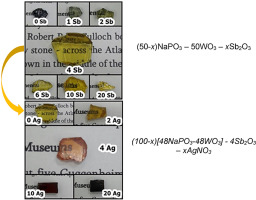Our official English website, www.x-mol.net, welcomes your feedback! (Note: you will need to create a separate account there.)
Effect of silver and antimony on optical properties of tungsten-phosphate glasses
Journal of Luminescence ( IF 3.6 ) Pub Date : 2020-07-01 , DOI: 10.1016/j.jlumin.2020.117191 F.P.S. Santos , Marcos de Oliveira , M. Reza Dousti , M.V.D. Vermelho
Journal of Luminescence ( IF 3.6 ) Pub Date : 2020-07-01 , DOI: 10.1016/j.jlumin.2020.117191 F.P.S. Santos , Marcos de Oliveira , M. Reza Dousti , M.V.D. Vermelho

|
Abstract The effect of silver ions on the photochromic properties of tungsten phosphate glass is investigated. All samples when excited at 377 nm exhibit ~430 nm luminescence attributed to the charge transfer mechanism within the W O 4 2 − tungstate anions. The broad absorption band extending from ultraviolet to the visible region, between 500 and 1400 nm, of the NaPO3-WO3 (PW) base matrix due to the small-polarons ( W x 5 + W 1 − x 6 + O 3 ) transferring charges between neighboring tungsten ions according to the following photon absorption W A 5 + + W B 6 + + h v s → W A 6 + + W B 5 + . The dual oxidation state of the antimony, Sb3+ and Sb5+, incorporated into the matrix at the 0 . 5 − x N a P O 3 − 0 . 5 W O 3 − x S b 2 O 3 x = 0 … 0 . 2 m o l % (PWS) ratio acts as a reducing element of the W5+ ions leading to the suppression of polarons as UV-VIS absorption centers. These results are confirmed by EPR measurements with scanned magnetic field between 2500 and 4500G. The most intense effect is observed for nominal doping above A g N O 3 ≥ 10 m o l % . The temporal dynamics of luminescence at ~430 nm as a function of UV exposure time shows that both, W x 5 + W 1 − x 6 + O 3 for PW glasses as well as Ag+ for PWSA glasses act as traps for the charge generated by the excited W O 4 2 − anions. Photodarkening due to continuous exposure to UV radiation reduces the pump transmission by ~12% of its initial value for PW and PWSA glasses. This is attributed to F-center formation (Ag+) which acts traps to the photoexcited electrons. This is attributed to oxidation of silver ions (Ag+) becoming metallic silver (Ag0). The effect when compared to PWS glass was observed to be reduced by only 2% over the same interval under the same pumping conditions.
中文翻译:

银和锑对磷酸钨玻璃光学性能的影响
摘要 研究了银离子对磷酸钨玻璃光致变色性能的影响。所有样品在 377 nm 激发时都表现出~430 nm 的发光,这归因于 WO 4 2 - 钨酸盐阴离子内的电荷转移机制。由于小极化子 (W x 5 + W 1 − x 6 + O 3 ) 转移电荷,NaPO3-WO3 (PW) 基体的从紫外到可见区的宽吸收带在 500 到 1400 nm 之间延伸相邻钨离子之间根据以下光子吸收 WA 5 + + WB 6 + + hvs → WA 6 + + WB 5 + 。锑的双氧化态,Sb3+ 和 Sb5+,在 0 处并入基体。5 - x N a PO 3 - 0 。5 WO 3 − x S b 2 O 3 x = 0 … 0。2 mol % (PWS) 比率充当 W5+ 离子的还原元素,导致抑制作为 UV-VIS 吸收中心的极化子。这些结果由 EPR 测量证实,扫描磁场在 2500 到 4500G 之间。当标称掺杂超过 Ag NO 3 ≥ 10 mol% 时观察到最强烈的影响。作为 UV 曝光时间函数的~430 nm 发光的时间动态表明,PW 玻璃的 W x 5 + W 1 − x 6 + O 3 以及 PWSA 玻璃的 Ag+ 都充当了由激发态的 WO 4 2 - 阴离子。由于持续暴露于紫外线辐射而导致的光暗化将泵浦透射率降低了 PW 和 PWSA 玻璃初始值的约 12%。这归因于 F 中心形成 (Ag+),它对光激发电子起到陷阱的作用。这归因于银离子 (Ag+) 氧化变成金属银 (Ag0)。在相同的泵送条件下,与 PWS 玻璃相比,观察到的效果在相同的间隔内仅降低了 2%。
更新日期:2020-07-01
中文翻译:

银和锑对磷酸钨玻璃光学性能的影响
摘要 研究了银离子对磷酸钨玻璃光致变色性能的影响。所有样品在 377 nm 激发时都表现出~430 nm 的发光,这归因于 WO 4 2 - 钨酸盐阴离子内的电荷转移机制。由于小极化子 (W x 5 + W 1 − x 6 + O 3 ) 转移电荷,NaPO3-WO3 (PW) 基体的从紫外到可见区的宽吸收带在 500 到 1400 nm 之间延伸相邻钨离子之间根据以下光子吸收 WA 5 + + WB 6 + + hvs → WA 6 + + WB 5 + 。锑的双氧化态,Sb3+ 和 Sb5+,在 0 处并入基体。5 - x N a PO 3 - 0 。5 WO 3 − x S b 2 O 3 x = 0 … 0。2 mol % (PWS) 比率充当 W5+ 离子的还原元素,导致抑制作为 UV-VIS 吸收中心的极化子。这些结果由 EPR 测量证实,扫描磁场在 2500 到 4500G 之间。当标称掺杂超过 Ag NO 3 ≥ 10 mol% 时观察到最强烈的影响。作为 UV 曝光时间函数的~430 nm 发光的时间动态表明,PW 玻璃的 W x 5 + W 1 − x 6 + O 3 以及 PWSA 玻璃的 Ag+ 都充当了由激发态的 WO 4 2 - 阴离子。由于持续暴露于紫外线辐射而导致的光暗化将泵浦透射率降低了 PW 和 PWSA 玻璃初始值的约 12%。这归因于 F 中心形成 (Ag+),它对光激发电子起到陷阱的作用。这归因于银离子 (Ag+) 氧化变成金属银 (Ag0)。在相同的泵送条件下,与 PWS 玻璃相比,观察到的效果在相同的间隔内仅降低了 2%。



























 京公网安备 11010802027423号
京公网安备 11010802027423号